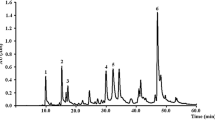Abstract
Acetylcholinesterase inhibitors (AChEIs) are important for treatment of Alzheimer’s disease and other neurological disorders. Search for potent and safe AChEIs from plant sources still continues. In the present work, we explored fragrant plant extracts that are traditionally used in flavoring foods, namely, Hemidesmus indicus and Vanilla planifolia, as possible sources for AChEI. Root and pod extracts of H. indicus and V. planifolia, respectively, produce fragrant phenolic compounds, 2-hydroxy-4-methoxybenzaldehyde (MBALD) and 4-hydroxy-3-methoxybenzaldehyde (vanillin). These methoxybenzaldehydes were shown to have inhibitory potential against acetylcholinesterase (AChE). Vanillin (IC50 = 0.037 mM) was detected as more efficient inhibitor than MBALD (IC50 = 0.047 mM). This finding was supported by kinetic analysis. Thus, plant-based food flavoring agents showed capacity in curing Alzheimer’s disease and other neurological dysfunctions.

Similar content being viewed by others
Abbreviations
- MBALD:
-
2-hydroxy-4-methoxybenzaldehyde
- AChE:
-
Acetylcholinesterase
- AChEI:
-
Acetylcholinesterase inhibitor
References
Saklani A, Kutty SK (2008) Plant-derived compounds in clinical trials. Drug Discov Today 13:161–171
Greenblatt HM, Dvir H, Silman I, Sussman JL (2003) Acetylcholinesterse. J Mol Neurosci 20:369–383
Mukherjee PK, Kumar V, Mal M, Houghton PJ (2007) Acetylcholinesterase inhibitors from plants. Phytomedicine 4:289–300
Houghton PJ, Ren Y, Howes MJ (2006) Acetylcholinesterase inhibitors from plants and fungi. Nat Prod Rep 23:181–199
Schulz V (2003) Ginkgo extract or cholinesterase inhibitors in patients with dementia: what clinical trial and guidelines fail to consider. Phytomedicine 10:74–79
Jain SK (1994) Medicinal plants. National Book Trust, New Delhi, pp 95–96
Sircar D, Dey G, Mitra A (2007) A validated HPLC method for simultaneous determination of 2-hydroxy-4-methoxybenzaldehyde and 2-hydroxy-4-methoxybenzoic acid in root organs of Hemidesmus indicus. Chromatographia 65:349–353
Walton NJ, Mayer MJ, Narbad A (2003) Vanillin. Phytochemistry 63:505–515
Akhtar MN, Lam KW, Abas F, Maulidiani AS, Shah SAA, Rahman A, Choudhary MI, Lajis NH (2011) New class of acetylcholinesterase inhibitors from the stem bark of Knema laurina and their structural insights. Bioorg Med Chem Lett 21:4097–4103
Mata AT, Proenca C, Ferreira AR, Serralheiro MLM, Nogueira JMF, Araujo MEM (2007) Antioxidant and antiacetylcholinesterase activities of five plants used as Portuguese food spices. Food Chem 103:778–786
Ding HY, Chou TH, Lin RJ, Chan LP, Wang GH, Liang CH (2011) Antioxidant and antimelanogenic behaviors of Paeonia suffruticosa. Plant Foods Hum Nutr 66:275–284
Chakraborty D, Sircar D, Mitra A (2008) Phenylalanine ammonia-lyase-mediated biosynthesis of 2-hydroxy-4-methoxybenzaldehyde in roots of Hemidesmus indicus. J Plant Physiol 165:1033–1040
Gu X, Zhang Z, Wan X, Ning J, Yao C, Shao W (2009) Simultaneous distillation extraction of some volatile flavor components from Pu-erh tea samples—comparison with steam distillation- liquid/liquid extraction and soxhlet extraction. Int J Anal Chem 2009:1–6
He X (2003) A continuous spectrophotometric assay for the determination of diamondback moth esterase activity. Arch Insect Biochem Physiol 54:68–76
Kundu A, Jawali N, Mitra A (2012) Shikimate pathway modulates the elicitor-stimulated accumulation of fragrant 2-hydroxy-4-methoxybenzaldehyde in Hemidesmus indicus roots. Plant Physiol Biochem 56:104–108
Pohanka M, Musilek K, Kuca K (2009) Progress of biosensors based on cholinesterase inhibition. Curr Med Chem 16:1790–1798
Dauterman WC (1982–83) The role of hydrolases in insecticide metabolism and the toxicological significance of the metabolites. J Toxicol Clin Toxic 196/197:623–635
Gomori G (1953) Human esterase. J Lab Clin Med 42:445–453
Szajdek A, Borowska EJ (2008) Bioactive compounds and health promoting properties of berry fruits: a review. Plant Foods Hum Nutr 63:147–156
Grutzendler J, Morris JC (2001) Cholinesterase inhibitors for Alzheimer’s disease. Drugs 61:41–52
Menichini F, Tundis R, Loizzo MR, Bonesi M, Marrelli M, Statti GA, Menichini F, Conforti F (2009) Acetylcholinesterase and butyrylcholinesterase inhibition of ethanolic extract and monoterpenes from Pimpinella anisoides V Brig. (Apiaceae). Fitoterapia 80:297–300
Savelev S, Okello E, Perry NSL, Wilkins RM, Perry EK (2003) Synergistic and antagonistic interactions of anticholinesterase terpenoids in Salvia lavandulaefolia essential oil. Pharmacol Biochem Behav 75:661–668
Illum L (2000) Transport of drugs from the nasal cavity to the central nervous system. Eur J Pharm Sci 11:1–18
Bachman DL, Wolf PA, Linn RT (1992) Prevalence of dementia and probable senile dementia of the Alzheimer type in the Framingham study. Neurology 42:115–119
Schneider LS (2001) Treatment of Alzheimer’s disease with cholinesterase inhibitors. Clin Geriatr Med 17:337–339
Liu JS, Zhu YL, Yu CM, Zhou YZ, Han YY, Wu FW, Qi BF (1986) The structures of huperzine A and B1, two new alkaloids exhibiting marked anticholinesterase activity. Can J Chem 64:837–839
Fimognari C, Lenzi M, Ferruzzi L, Turrini E, Scartezzini P, Poli F, Gotti R, Guerrini A, Carulli G, Ottaviano V, Cantelli-Forti G, Hrelia P (2011) Mitochondrial pathway mediates the antileukemic effects of Hemidesmus indicus, a promising botanical drug. PLoS One 6:e21544
Ishidate M, Sofuni T Jr, Yoshikawa K, Hayashi M, Nohmi T, Sawada M, Matsuoka A (1986) Primary mutagenicity screening of food additives currently used in Japan. Food Chem Toxicol 22:623–636
Acknowledgements
This work was supported in part by a research grant (no. 2008/37/7/BRNS to A. Mitra) from the Board of Research in Nuclear Sciences (BRNS), Department of Atomic Energy, Government of India.
Conflict of Interest
The authors declare that they have no conflict of interest.
Author information
Authors and Affiliations
Corresponding author
Electronic supplementary material
Below is the link to the electronic supplementary material.
ESM 1
(DOC 145 kb)
Rights and permissions
About this article
Cite this article
Kundu, A., Mitra, A. Flavoring Extracts of Hemidesmus indicus Roots and Vanilla planifolia Pods Exhibit In vitro Acetylcholinesterase Inhibitory Activities. Plant Foods Hum Nutr 68, 247–253 (2013). https://doi.org/10.1007/s11130-013-0363-z
Published:
Issue Date:
DOI: https://doi.org/10.1007/s11130-013-0363-z




